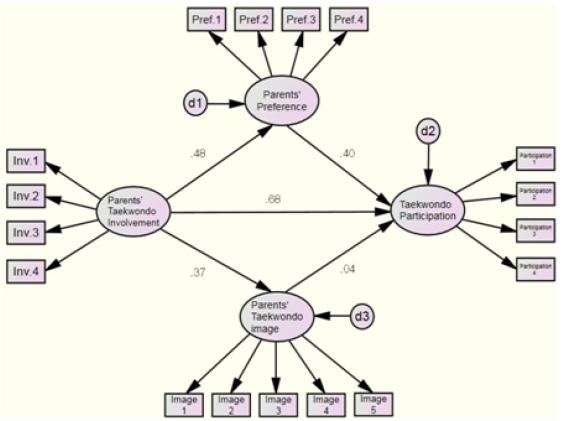


태권도는 청소년들에게 유익한 여가활동으로써 부모들 사이에서 선호되고 있고 초중학생들의 참여가 높은 편이다. 부모들은 청소년들의 여가활동 및 다양한 활동들의 재원제공자로써 청소년들의 여가활동 참여의 중요한 결정요인으로 작용할뿐만 아니라 부모의 관여는 자녀의 학습 동기나 참여에 중요한 요인으로 작용한다. 따라서 부모가 청소년 여가활동 참여에 미치는 영향들에 대한 이해를 넓히고자 본 연구에서는 부모의 태권도에 대한 관여도와 자녀의 태권도 참여와의 관계를 알아보고자 하였고 연구를 위해 서울지역에 소재하는 초등학교 재학생 부모 498명을 대상으로 설문조사를 하였다. 자료처리는 SPSS ver. 15.0 과 AMOS 7.0을 활용하여 모형의 적합도 검증을 확인한 후 개별 가설을 검증 하였으며 검증결과 다음과 같은 결론을 얻을 수 있었다. 첫째, 부모의 태권도에 대한 관여도는 자녀의 태권도를 참여함에 있어 절대적 영향을 미치는 중요한 변인임을 알 수 있었다. 둘째, 부모의 태권도에 대한 관여도는 태권도선호도에 유의한 영향을 미치는 것으로 나타났다. 셋째, 부모의 태권도에 대한 관여도는 태권도이미지에 유의한 영향을 미치는 것으로 나타났다. 셋째, 부모의 태권도에 대한 관여도는 태권도이미지에 유의한 영향을 미치는 것으로 나타났다. 부모의 태권도에 대한 관여도는 태권도선호도 및 이미지에 긍정적 혹은 부정적으로 연결되어짐을 의미하며, 부모의 태권도에 대한 관여가 긍정적일수록 선호도와 이미지도 향상되어짐을 알 수 있다. 넷째, 부모의 태권도선호도는 자녀의 태권도참여에 유의한 영향을 미치는 것으로 나타났다. 다섯째, 부모의 태권도이미지는 자녀의 태권도참여에 유의한 영향을 미치는 것으로 나타났다.
The popularity of taekwondo has grown tremendously during the past decades, and today, its spur of growth is evidenced by boasting number of approximately 80 million participants in 182 different countries throughout the world (Kukkiwon, 2006). Taekwondo is not only a cultural icon of Korea but is also becoming recognized as an important representative part of Asian culture as a popular sport and martial art. The Korea Taekwondo Association (KTA) reported that there are over 8,000 registered taekwondo facilities in Korea, and including those that are not registered the number is expected to surpass ten thousand.
Recently, the pace of maturity among youths has gotten quicker, and parents' interest and enthusiasm in education for their children is starting to grow at a much younger age. Along with socioeconomic changes such as increase in economic participation ratio among women and improvement of household economy, the number of youth participation in educational institutions such as taekwondo studios and English academy is growing at a rapid rate. Meanwhile, the average age of these youth participants are decreasing. Among various options of educational activities, physical education in particular is gaining much interest among many parents of elementary school students as extensive body of research studies suggest that physical activities enhance both physical development, interpersonal competence, self-concept, school engagement, and educational aspirations among youths (Elder & Conger, 2000; Marsh & Kleitman, 2002; Youniss, McLellan, & Yates, 1999).
Childhood or elementary school is a critical stage for physical, emotional, and psychological development. The values and emotions developed during this phase play a crucial role in one's entire life (Aviles, Anderson, & Davila, 2006).
With the contributions of many research studies, there is a growing awareness among parents of the positive influence of physical activities on children's physical, psychological, and social development. This resulted in increasing number of youth sport participation including martial arts. Among different martial arts, taekwondo is the most popular one with the highest participation rate in Korea. It is also preferred by parents because taekwondo not only teaches self-defense, it also emphasizes on important values such as etiquette, justice, and ethical discipline (Yang, 2003).
In response to growing demand of taekwondo among elementary school students, many taekwondo programs are going through transformations both quantitatively and qualitatively. As evidenced from growing stream of empirical research studies on taekwondo and its positive influence on youths during developmental stage (e.g. IQ development, physical fitness, physical balance and harmony, mental strength, and character development), the benefits of taekwondo participation is often highlighted as a marketing pitch. Therefore, the results of aforementioned studies can be expected to act as a motivators for non-participants to participate in taekwondo.
However, despite the growing awareness of taekwondo benefits, a study by Yang (2003) presented an interesting phenomenon. According to his study, participation rate among younger age (i.e., preschool and elementary school students) is significantly higher than that of the older population (i.e., middle-, high school students, adults), and the participation rate among older population is continuously decreasing. In other words, the average age of taekwondo participation is decreasing. Yang (2003) implied that perhaps this phenomenon can be explained by the change in parents' preference for taekwondo among older students since parents are the providers of the means (e.g., rides, fees, support). Thus, we can make an intuitive supposition that optimistic and receptive attitude of parents toward taekwondo may positively influence the youth participation rate of taekwondo. Another plausible reason for decrease in taekwondo participation rate among older population could be the lack of marketing efforts in martial arts lagging behind other business industries (Ko, 2003; Ko & Yang, 2008). Although there are numerous studies that have examined the motivational aspects of taekwondo training (e.g., Columbus & Rice, 1991; Cox, 1993; Yang, 1996), little has been researched concerning the factors that actually drives demand for taekwondo such as parents' involvement.
This is in line with Hill's (1993) suggestion that many successful people in sport began participating in sport activities at early ages of five or six, and their initial interest in sport is often significantly influenced by their parent. Similarly, Hoyle and Leff (1997) posited that parents often assume the role of motivator, facilitator, even coach in the life of the young athlete. In these roles parents can provide financial, emotional, and physical support. Howard and Madrigal (1990) suggested that it is typically a parent, usually the mother who decides which sport program the child is first enrolled. They further implied that the parents play more important role not only because they are the purchasers but also those that often provide the volunteer labor necessary to maintain their children's sport program. These studies highlight the importance of parents' role in youth participation of sports or physical activities.
There are other studies that explored the role of parents on youth participation in different dimensions. For example, a study on the parents as a influential socializer was done by Jodl, Michael, Malanchuk, Eccles, & Sameroff (2001) arguing that parents play a pivotal roles in shaping early adolescents' occupational aspirations. The implication of this study suggests that the influence of parents during the developmental stage play a significant role in practically every aspects of adolescents' life. According to the result of her study, the majority of students who had high levels of motivations for, and also excelled in sports had parents that either participated in sport activities, or had positive attitude toward physical activities. This is an implication that successful experience or goal achievement among youth in sport activities are influenced by the parents' involvement with their children's sport activities.
The importance of parents role, more specifically the level of their involvement is also found in studies outside of sport or leisure studies. Strong correlations between parental involvement and student academic performance were found in several studies (e.g., Crane, 1996; Jeynes, 2001; Zdzinksi, 1996). In addition, Brown (1989) suggested that parent involvement enhances student self-esteem, and improves child-parent relationships.
As suggested by extensive body of literatures emphasizing on the importance of parents in many different aspects, the purpose of this study is to perform an empirical study on the effects of parents' involvement with taekwondo on youth participation. As already mentioned, the majority of taekwondo participants in Korea today are elementary school students. Thus, this study will investigate the parents of elementary school students that are currently participating in taekwondo. With the result of this study we hope to contribute to the stream of researches that are aimed to promote growth of taekwondo participation.
This study utilized convenience sampling to distribute self-administered questionnaire survey to parents at an elementary school in Seoul. Total of 430 surveys were distributed, and 398 surveys were retrieved and deemed usable for the analysis. Based on the demographic analysis of the participants, 13.3% of the participants were fathers, 85.3% were mothers, and 1.5% were others. Among the reported occupations of the parents, 19.5% were salaryman, 7.8% were self-employed, 59.8% were housewives, and 6.8% were government employees. On a question regarding taekwondo experience 38.3% participants reportedly had previous experience and 61.8% had no previous experience. Other details of demographic analysis is shown in <Table 1>.
[Table 1] Demographic analysis of participants
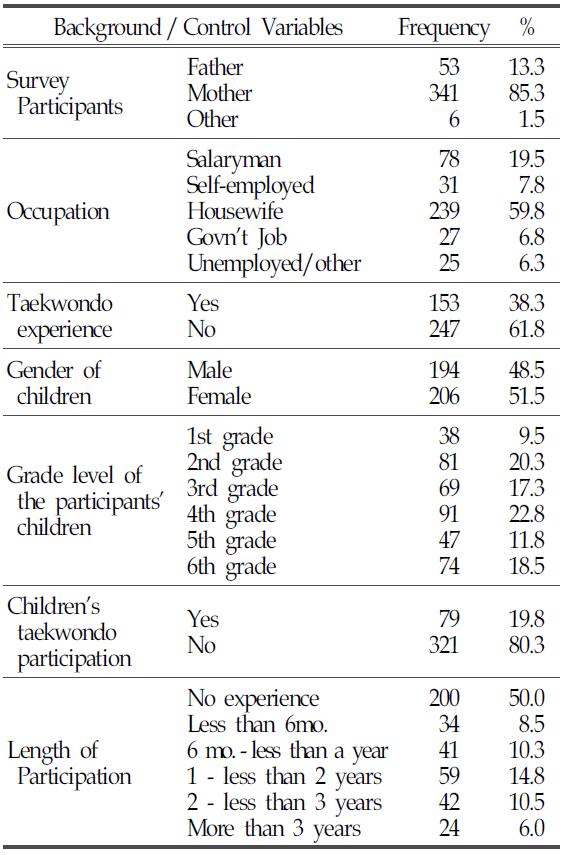
Demographic analysis of participants
The measurement scales implemented for this study are as follows: Zaichkowsky's (1994) personal involvement inventory for 'parents' taekwondo involvement'; Kahle's (1983) list of value and Yoo and Lee's (2006) sport preference model for 'parents' taekwondo preference'; Yoo and Lee's (2006) analysis model of measuring the effects of sport image advertisement for 'parents' taekwondo image'; and Chung's (1991) analysis on the determinants of fitness center participation for 'youth taekwondo participation intention'. All items were measured on 5-point Likert scale.
In order to construct a measurement tool for this study, a pilot study was conducted with 160 preliminary surveys retrieved from the parents of an elementary school in Seoul. Exploratory factor analysis (EFA) was conducted using AMOS 7.0 and items that reduced the unidimensionality of the measurement (4 items for 'image' and 2 items for 'preference') were removed. After removal of those items the construct of the survey was appropriate as Nunnally (1978) suggested with Crobach's α values exceeding 0.70, and eigen values greater 1.0 and factor loadings greater than 0.40. The result of confirmatory factor analysis is as shown in <Table 2>. Total of four factors were extracted, and they are as follows: parents' taekwondo involvement, parents' taekwondo preference, parents' perceived taekwondo image, and youth taekwondo participation intention.
[Table 2] Confirmatory factor analysis of the measurement model

Confirmatory factor analysis of the measurement model
Using the finalized measurement model, a correlation analysis, test of goodness-of-fit of structural model, and path analysis was performed using SPSS 15.0 and AMOS 7.0.
1) Correlation Analysis
As shown in <Table 3>, parents' taekwondo involvement, preference, perceived image, youth participation intention were all correlated at statistically significant level (p=.01). The correlation coefficient between parents' taekwondo involvement and youth taekwondo participation intention was .634 (p=.01), and between parents' taekwondo preference and perceived taekwondo image was .523 (p=.01)
[Table 3] Correlations Analysis
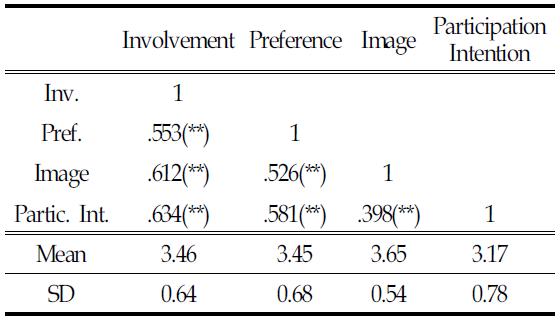
Correlations Analysis
2) Structural Equation Modeling (SEM)
The test of goodness-of-fit result for structural model is shown in <Table 4>, and the result of structural model analysis is shown in <Figure 1>.
[Table 4] Test of Goodness-of-fit for Structural Model

Test of Goodness-of-fit for Structural Model
As shown above, the result of test of goodness-of-fit for the research model showed NFI=.909, GFI=.913, and CFI=.938 suggesting that the research model is reliable. Then the hypotheses of the structural equation model were tested. Based on the result of the analysis, all of the hypotheses except H5 were accepted. The standardized path coefficient of the research model is shown in <Table 5>.
[Table 5] Standardized path coefficient of the research model.
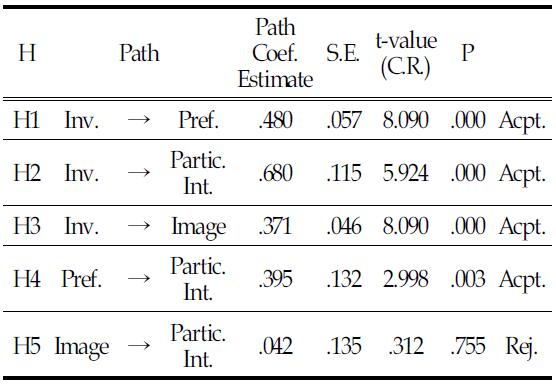
Standardized path coefficient of the research model.
3) Causal Effect
The causal effects between the variables can be deducted from the analysis of the research model, and they can be classified into direct and indirect effects. Direct effect refers to the direct path coefficient between two variables, where indirect effect refers to the independent variable influencing the dependent variable through one or more mediating variables (Kim, 2007). The causal effects of the research model is illustrated in <Table 6>.
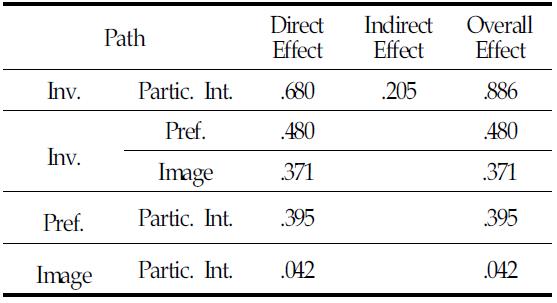
Causal Effects
It should be noted that theresult shown in <Table 6> is identical to the path coefficients shown in <Table 5>. Therefore, the causal relationship and effects between latent variables should be considered with paying attention to the analysis of the indirect effects. The results of the analysis suggest that parents' taekwondo preference and parents' perceived image of taekwondo have mediating effects between parents' taekwondo involvement and youth taekwondo participation intention.
Recently, a stream of research studies emphasizing the importance of physical activities on physical and brain development among youths have sparked the parents' interest in youth physical education. In fact, the participation rate of elementary school students in various physical activities including martial arts is growing at a rapid rate. In case of martial arts, taekwondo in particular is the most preferred activity among youths in elementary school.
In response to the growing interest and demand for taekwondo, it is necessary to have an understanding of what influence the intention of participation. This understanding may provide insightful information that can be useful for designing marketing programs.
Based on the suggestions of previous literatures, we expected that parents' involvement with taekwondo will have effect on youth participation of taekwondo. In order to empirically test its causal effect of, we developed and tested five hypotheses. The first hypothesis, 'parents' taekwondo involvement will have effect on parents' preference for taekwondo' was accepted, and the result showed that they are positively correlated. This similar to the findings of Yom and Park's (2006) study suggesting that the consumers' preference and attitude towards the advertised product is influenced by the levels of consumers' involvement. The second hypothesis, 'parents' taekwondo involvement will have effect on youth taekwondo participation intention' was accepted. This is similar to the findings of Cobb-Walgren, Beal, & Donthu (1995) study on the influence of consumers' involvement on their attitude towards the brand and advertisements. The third hypothesis, 'parents' taekwondo involvement will have effect on parents' perceived taekwondo image' was accepted. The fourth hypothesis, 'parents' preference for taekwondo will have effect on youth taekwondo participation intention' was accepted. This is supported by Yom and Park's (2006) findings that the consumers who has higher levels of preference for a TV advertisement showed higher levels of purchase intentions and positive attitude towards the brand. Lastly, the fifth hypothesis, 'Parents' perceived taekwondo image will have effect on youth taekwondo participation intention' was rejected since it was found to be statistically insignificant. In other words, the parents' image towards taekwondo did not influence the participation intention for taekwondo. This finding is contradictory to the widely supported one in that corporate image does in fact significantly influence purchase intentions (Laroche & Brisoux, 1989; Laroche, Kim, & Zhou, 1996). The reason for the difference in findings can be that it is possible that the influence of perceived image can be mediated by other things such as type of product or services (e.g., utility vs. hedonic). For the future studies, we suggest that it is necessary to further investigate the causal link between perceived image and behavioral intentions (i.e. purchase/participation intention).
The purpose of this study was to investigate the casual relationship and the effect of parents' taekwondo involvement on youth taekwondo participation intention using structural equation modeling based on the conceptual framework. Based on result of the analysis, the parents' involvement with taekwondo was found to not only directly effect the participation intention of their children but also had indirect effect mediated by parents' preference and perceived image towards taekwondo. Previous studies have suggested that parents play important roles as a socializer, supporters, and providers in youth sport participation. In line with such implications, we suggest that it is important for taekwondo managers to understand that increasing the level of parents' involvement with taekwondo may be a key to growth in taekwondo participation.
Managers may be able to increase the level of involvement among parents by offering free clinics or programs for the parents to learn the benefits of learning taekwondo and actually experiencing it themselves. Although empirical study may be useful to validate, but we can intuitively expect that classes for parents and their kids to learn together may also enhance the level of involvement among parents. This may influence the children's perception of towards taekwondo as well, further acting as a motivator for participation.
This study presents a findings that are in line with previous researches emphasizing the importance of parents for youth sport participation in different dimensions. However, the scope of this study was limited to the youths during elementary school years, and the implication of this study is insufficient to explain the phenomenon of decreasing participation rate among older population. Therefore, we suggest that the following research questions should be addressed in future studies to explain the decreasing participation rate among older participants: Is the effect of parents' involvement become weaker with age of their kids? Are there any structural constraints or changes in priority (i.e. academic studies for college admission) that effect continued participation? What are the key determinants of taekwondo participation among older population (e.g. middle- and high-school students, and adults). With answers to these questions, we believe that the managers can successfully tailor the marketing campaigns and class programs to retain high participation rate.




